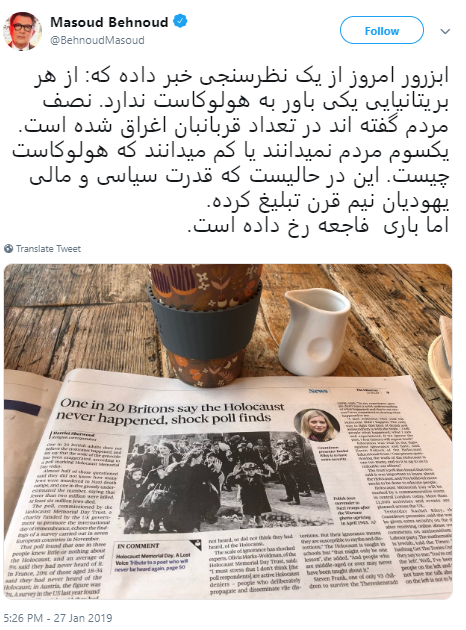“The BBC is committed to achieving due accuracy. This commitment is fundamental to our reputation and the trust of audiences, which is the foundation of the BBC. It is also a requirement under the Agreement accompanying the BBC Charter.”
The above quote comes from the introduction to section 3 of the BBC’s Editorial Guidelines, which go on to state that:
“All BBC output, as appropriate to its subject and nature, must be well sourced, based on sound evidence, thoroughly tested and presented in clear, precise language. We should be honest and open about what we don’t know and avoid unfounded speculation. Claims, allegations, material facts and other content that cannot be corroborated should normally be attributed.”
And:
“The BBC must not knowingly and materially mislead its audiences. We should not distort known facts, present invented material as fact or otherwise undermine our audiences’ trust in our content.”
Taking the above into account, it is interesting to examine specific sections of a report by the BBC’s Gaza correspondent Jon Donnison from August 21st 2102 which relates to the subject of smuggling tunnels in Rafah, in the Gaza Strip.
Donnison’s main point is that Egyptian clampdowns on the tunnels – in the wake of the August 5th terror attack on an Egyptian military base in Sinai in which 16 soldiers were killed – are having a detrimental effect on the Gaza smuggling trade.
Donnison stresses what he sees as the Gaza economy’s dependence on the smuggling tunnels (although the Palestinian Authority disputes such claims), but curiously throws in the following statement:
“Israel says weapons are also smuggled into Gaza.”
The frequent use of the phrase “Israel says” by journalists is a subject for discussion in itself. It implies to the reader that, whilst seemingly presenting multiple viewpoints on a certain subject, the journalist is not entirely convinced of their validity or objectivity.
Of course in this specific case, it is not just Israel which “says” that weapons are smuggled into Gaza through the tunnels.
In May 2012, Major General Warren James Whiting – commander of the Multinational Force and Observers in Sinai – said that advanced Russian-made missiles were being smuggled from Libya, through Egypt, into the Gaza Strip.
In the same month, Egyptian security sources told the newspaper Asharq Al-Awsat that:
“… the Egyptian authorities have observed increased activities by jihadist groups that are moving across Egypt’s border with the Gaza Strip, as well as the Egyptian border with Israel, via the Sinai Peninsula. The security source claimed that weapons smuggled from Libya, including BM-21 Grad missiles and other missile systems, have increasingly appeared in the hands of extremist groups since the beginning of the year.”
From the leaked US State Department cables we learn that in 2009 Egyptian Intelligence had told US officials that Iran was recruiting Bedouin in the Sinai for the purpose of smuggling weapons into the Gaza Strip. Further cables indicate that the US government is very aware of the arms smuggling problem and involved in countering it, as apparently is the UN.
Indeed, one would have to go to some lengths to avoid being aware of the long history of the smuggling of weapons into Gaza via various different routes, but usually culminating in the underground tunnels along the Philadelphia Corridor.
And if one did choose to cast doubts upon the use of the tunnels for arms smuggling, one should surely present an alternative explanation for the presence of the foreign-made long-range missiles in the Gaza Strip which are frequently used against Israeli civilian communities.
So is Jon Donnison’s claim entirely accurate? Whilst it is certainly true that “Israel says weapons are also smuggled into Gaza”, that is not an entire or accurate picture because other countries and organisations also acknowledge that indisputable fact and therefore Donnison’s statement is liable to mislead his readers.
After stating that most of the goods on sale in Gaza originate in Israel, Donnison turns his attention to the construction sector, which he claims has been badly affected by Egyptian clamp-downs on the smuggling tunnels. Donnison states that:
“Israel continues to enforce tight restrictions on the amount of building materials allowed into Gaza, saying they could fall into the hands of Hamas and be used for military purposes.”
The actual official Israeli government policy relates not to the amount of building materials, but to their nature, as described below:
“According to the new policy, whatever is NOT on the restricted list will be allowed into the Gaza Strip. The only goods that are currently restricted are arms, weapons and various war materials, and certain items that have military as well as civilian applications. Because of the problematic nature of these dual-use materials, construction materials are currently allowed in only for PA-approved projects that are under the supervision of international bodies.”
The list of dual use restricted materials is as follows:
In practice, thousands of tons of building materials are transported into Gaza on a regular basis and in accordance with their having been designated for a particular project. Thus we see, for example, that in June 2012 alone, 1,142 truckloads of building materials and 476 truckloads of ceramics and plumbing entered the Gaza Strip.
As well as monthly reports, COGAT also issues more detailed weekly reports and so, for example, we can see that in the week September 16th to 22nd 2012, 155 truckloads of aggregates, 27 truckloads of cement, 4 truckloads of iron and 10 truckloads of glass, aluminum and wood profiles entered the Gaza Strip – ie a total of 413 truckloads of construction materials in one week alone.
For a detailed look at projects in the Gaza Strip between 2010 and 2012, see this comprehensive COGAT report which includes details of 17 approved housing projects, 17 approved clinic projects, 70 approved new schools and 24 school renovation projects, 37 approved water and sewage projects, 14 approved road projects and 39 approved infrastructure projects – all since 2010.
So is Jon Donnison’s statement that “Israel continues to enforce tight restrictions on the amount of building materials allowed into Gaza, saying they could fall into the hands of Hamas and be used for military purposes” entirely accurate?
Obviously not: the restrictions relate to dual-use materials which are not designated for projects approved by the Palestinian Authority and under the supervision of international bodies and the fact is that what Donnison terms “tight restrictions” have resulted in the entry of 23,252 truckloads of building materials into the Gaza Strip between 2010 – 2012.
As for the second part of Donnison’s claim, the list of dual-use goods is based upon the Wassenaar Arrangement on Export Controls for Conventional Arms and Dual-Use Goods and Technologies, indicating once again that it is not just a case of “Israel saying” that such materials could be used for military purposes by the many terrorist organisations active in the Gaza Strip.






